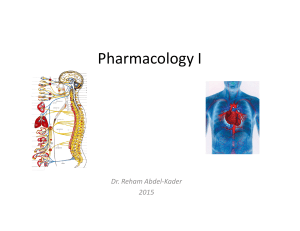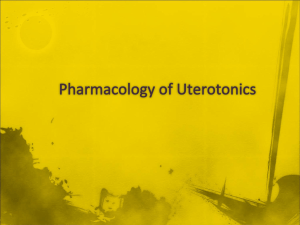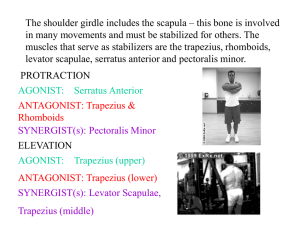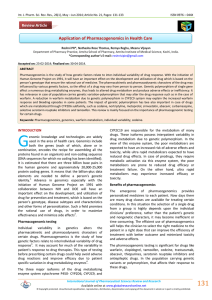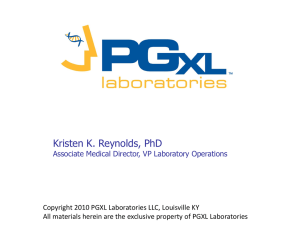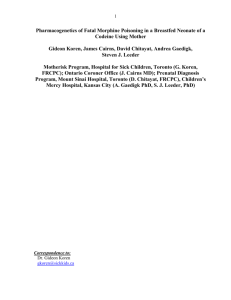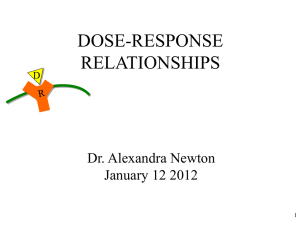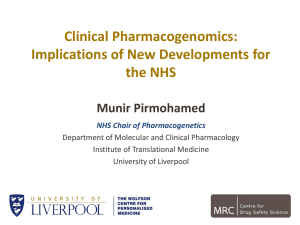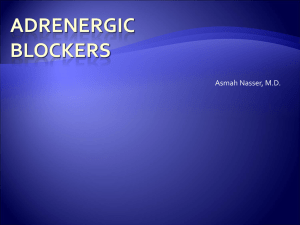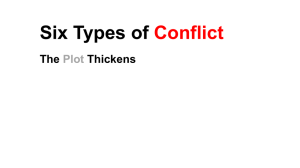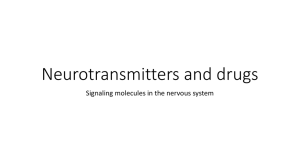Class Slides
advertisement
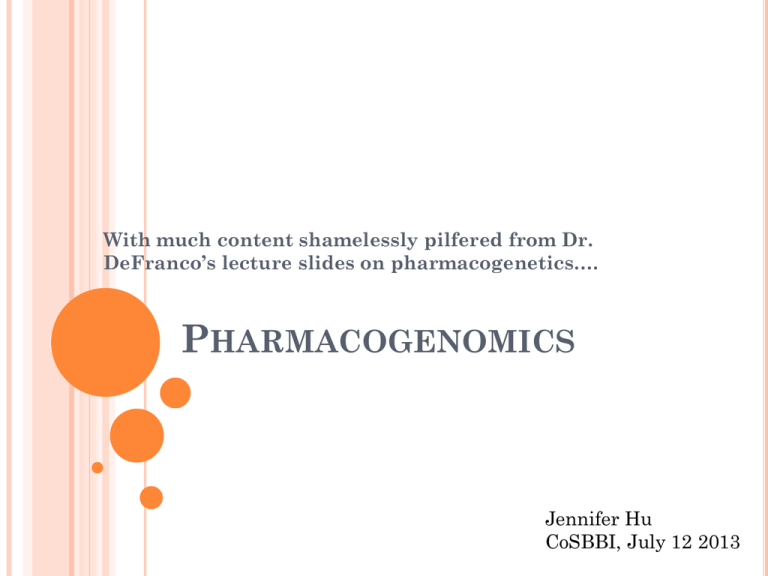
With much content shamelessly pilfered from Dr. DeFranco’s lecture slides on pharmacogenetics…. PHARMACOGENOMICS Jennifer Hu CoSBBI, July 12 2013 A FEW QUESTIONS TO GET US STARTED… What is pharmacogenomics? What is pharmacogenetics? How do (most) clinical drug trials work? Name some factors that are currently taken into consideration when prescribing drugs… PHARMACOGENOMICS VS. PHARMACOGENETICS Pharmacogenetics focuses on variation in one or a few genes Pharmacogenomics uses genome-wide information to predict drug response. What factors do we consider now when prescribing drugs? Age Gender Weight Therapeutic drug monitoring Organ function Future goal: personalized medicine! Give the right drug to the right patient at the correct dosage. (The assigned reading provides many examples of how things can go terribly awry if genetic factors are not taken into consideration.) Need for companion diagnostic tests! Ideas about what questions that we’d want to answer? WHICH GENES MIGHT BE IMPORTANT? Pharmacokinetic (PK) genes: absorption, distribution, metabolism, and excretion. Pharmacodynamic (PD) genes: direct targets themselves, genes affected downstream, and the genes responsible for the clinical outcome. Now you should be able to correctly answer the question on the pretest: “The sites for genetic variations that might affect drug response include…” AN EXAMPLE OF PHARMACOKINETIC GENE INTERACTIONS: LIVER DRUG METABOLIZING ENZYMES Phase I: oxidation, reduction, hydrolysis etc. Major system is cytochrome P450 (CYP) enzymes Phase II: conjugating enzymes (acetylation, glucuronidation, glutathionation, sulfation) Metabolizing reactions transform drugs into more water soluble forms to aid in their elimination SOME DRUG METABOLIZING ENZYMES SHOWING CLINICALLY SIGNIFICANT VARIATION CYP2D6 Role in metabolizing ¼ of all prescription drugs currently on the market Anti-depressants (SSRIs, tricyclics) Anti-psychotics b-blockers; some anti-arrhythmics CYP2C9 Warfarin (Coumadin®) UGT1A1 Irinotecan (Camptosar®) CASE 22 year old woman with symptoms suggesting depression. Her primary care physician prescribes venlafaxine (Effexor®). This is an SSRI. As an aside, what are symptoms of depression? 10 days later, the patient presents with complaints of racing heart rate and confusion. The physician questions whether she has taken codeine in the past. (WHY?) She says she was prescribed codeine/acetaminophen (Tylenol 3) after routine surgery 5 years ago and did not get pain relief. Morphine, however, was effective at that time. QUESTIONS FOR CASE What are possible explanations for the patient’s symptoms? What about the reported history of ineffectiveness of codeine but effectiveness of morphine? …. Also, since we are talking about drug metabolizing enzymes, which one is the suspect here? What are possible explanations for the patient’s symptoms? Overdose of drug (intentional or inadvertent) Low activity of CYP2D6 due to genetic variation (poor metabolizer) or the patient may be taking another drug which inhibits CYP2D6 activity Liver failure What about the reported history of ineffectiveness of codeine but effectiveness of morphine? Codeine is a pro-drug that needs to be converted to morphine (mainly by CYP2D6) With low CYP2D6 activity, codeine will not be converted to morphine In a Canadian study, there were no poor metabolizers in a population of several hundred codeine addicts No conversion to morphine means no euphoric effects So, what happened was likely that her metabolism of drug was slower than average adverse drug reaction with standard dose Poor metabolizer! Two copies of low or null activity gene. There are also ultra-rapid metabolizers (usually due to gene multiples), extensive metabolizers (normal), and intermediate metabolizers. Another note that may be of interest- the tragic tale of CYP2D6 ultra-rapid metabolizers and their breast-fed children AN EXAMPLE OF PHARMACODYNAMIC INTERACTIONS: WARFARIN Warfarin (coumadin) is a commonly prescribed oral anti-coagulant. Common cause of adverse drug reactions: too much drug results in increased bleeding, too little results in inadequate anti-coagulation (leading to possible stroke, DVT etc.) Need for monitoring Drug target: vitamin K epoxide reductase complex subunit 1 (VKORC1 or VKOR) Vit K needs to be converted from inactive epoxidized form to active reduced form Warfarin binds to VKORC1 near its catalytic site, inhibiting the reduction reaction. VKORC1 variants are associated with warfarin resistance in humans Clotting cascade BRIEF AND INCOMPLETE OVERVIEW OF DRUG-RECEPTOR INTERACTIONS What is an agonist? What is a partial agonist? What is an antagonist? What is an competitive antagonist? What is a non-competitive antagonist? SOME DEFINITIONS… Potency – A measure of the amount of ligand (drug) needed to produce an effect of an given magnitude (i.e. ED50). Efficacy – The effectiveness of a ligand or drug when eliciting a biological response. Is drug X or drug Z more potent? Is drug X or drug Y more efficacious? Agonist – A compound (drug) that binds to a receptor and produces a biological effect that mimics the endogenous ligand Partial agonists have efficacy greater than 0 but less than that of a full agonist Antagonist – A compound (drug) that binds to a receptor and blocks the action of its endogenous ligand or other agonists. Competitive antagonist Binds to the same site as the agonist 2. Doesn’t change the maximum response of an agonist but decreases its potency (i.e. right shift of dose response curve) 3. Competitive antagonism is surmountable at high enough concentrations of the agonist 1. Non-competitive antagonist 1. 2. 3. Bind to the same site as the agonist but dissociate so slowly to essentially irreversibly block agonist binding or bind to a distinct site (allosteric antagonist) and block agonist binding. The potency of an agonist won’t be affected but its maximum response will be reduced. Effects are non-surmountable by increasing agonist concentraion Now you should be able to answer the question: “For a competitive antagonist, all of the following are correct EXCEPT:…” DISCOVERY OF PHARMACOGENOMIC GENES AND VARIANTS Association Methods GWAS for SNPs (What is a SNP?) Chi square or Fisher’s exact test for association between SNP and trait* LR for continuous independent variable* Correct for multiple comparisons. WHY? Expression Methods RNA expression data from microarrays or RNA-Seq experiments from drug-treated samples Cheminformations/NLP Combining information about protein structure and small molecule structure, docking methods predict the best fit of a molecule Alternatively, if a given molecule is previously known to interact with a protein, molecule similarity metrics can be included to suggest similar molecules as protein-binding candidates. * We will do an example question at the end if there’s time… Also note that GWAS will be covered on July 17. WHAT HAPPENS NEXT…? Pathway discovery Validation: measuring binding affinity or functional assays Clinical trial!
